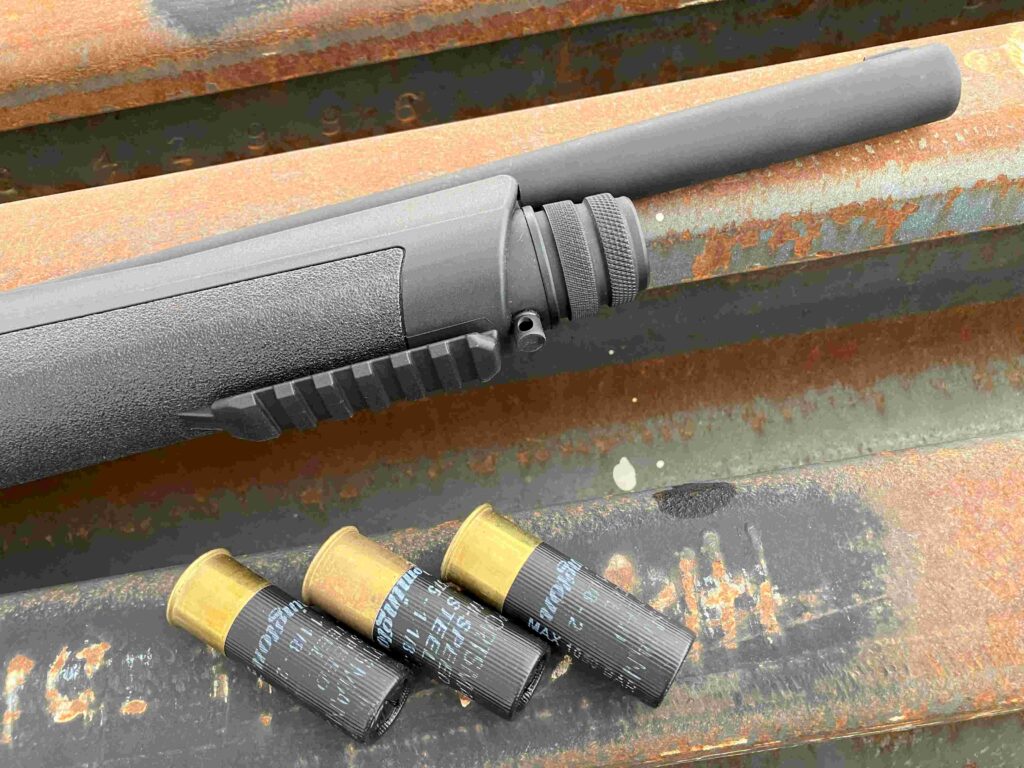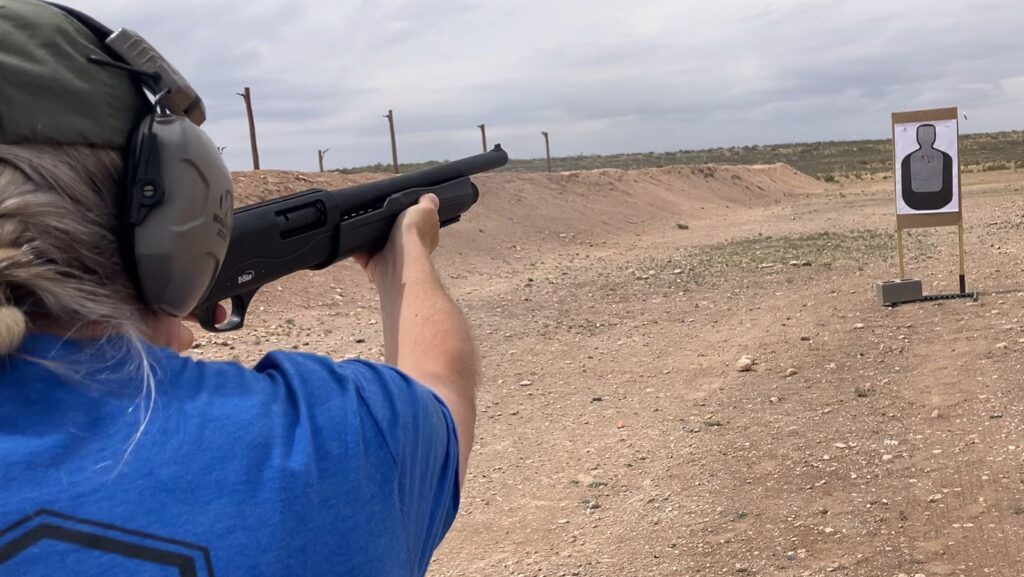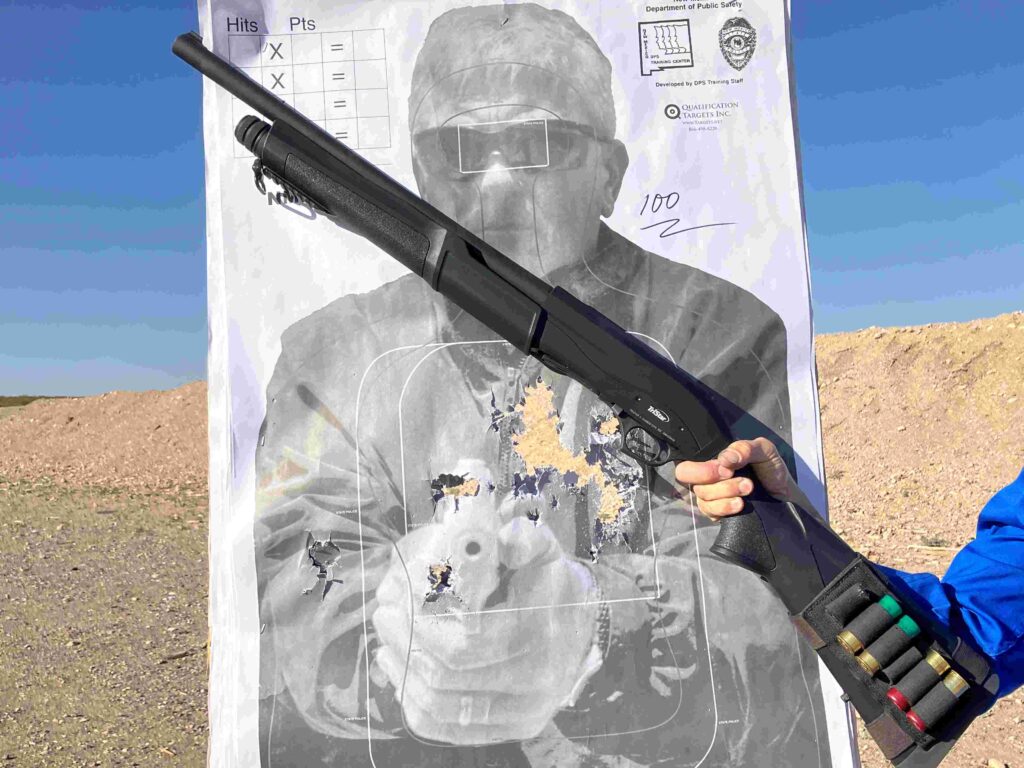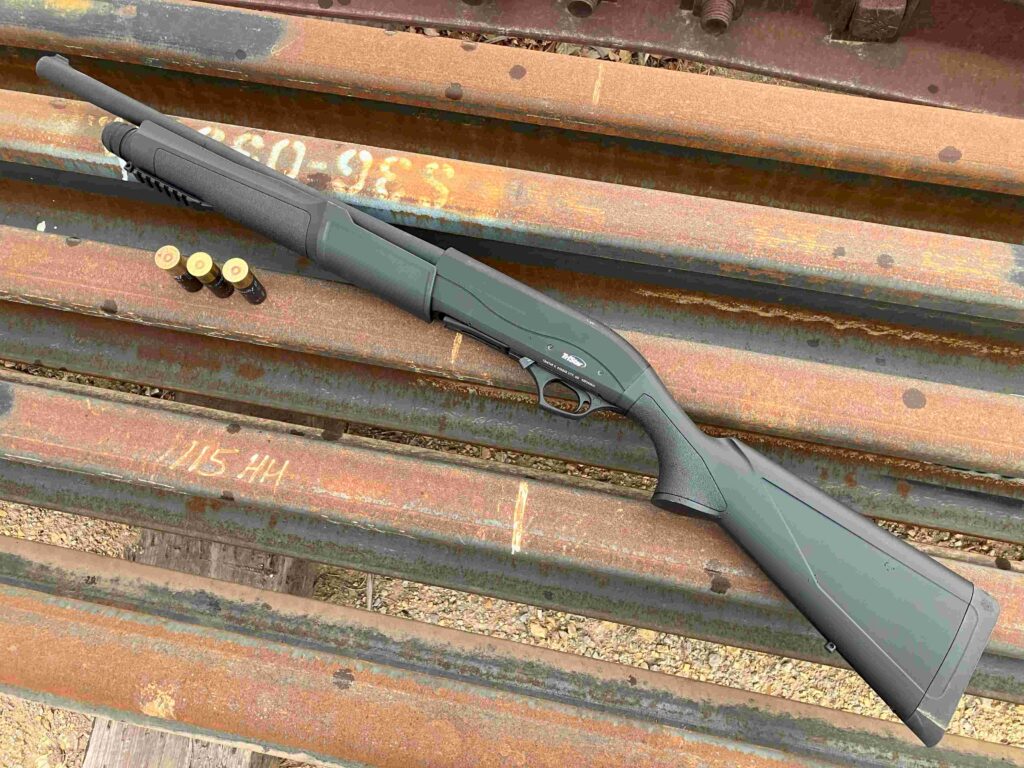Any defense plan for property, home, or business is made better with a shotgun. So much the better if it’s a tactical style, made for maneuverability and ready to accept helpful accessories. Though I’m a big fan of semiautos where bullet-expelling firearms are concerned, I’ve got a sweet spot for a pump action shotgun. There is something satisfying (and of course meme-worthy) in that chuk-chuk when loading.
One worthy and affordable player in this relatively small category is the Cobra III Tactical 12 gauge by TriStar Arms of Turkey. TriStar has an established, respected presence in the US market. I was lucky to get my hands on their Cobra III for a trial. The experience left me pleased, overall.
This handy scattergun is offered in two metal finishes, both with black synthetic furniture. The marine model features a stainless steel receiver and barrel. The plain model, which I tested, has black matte finish that I suspect is a nitride finish, though TriStar doesn’t say. Its matte finish is scratch-resistant but it does pick up the fine dust so prevalent in my desert homeland. The chrome-lined, 18-inch barrel has a plain end aside from a plain blade sight. An improved cylinder choke came pre-installed. A handy choke wrench and case for extra chokes were included, but I never changed this feature. The IC choke is well-suited for use with defensive ammunition, and would serve well enough shoud the gun need to be used for hunting. It’ll accommodate any size shell up to three inches, with a capacity of five.
In an age when many companies default to a respected company starting with “M” for polymer furniture, it’s nice to see something that’s a little different, if not remarkable in appearance. The stock is a standard traditional style, with a rubber recoil pad and sling stud. The forend is, for me, the winning feature of this gun. Why? Because I’m short, and have to remember to reach especially far to operate (and not get pinched by) other tactical pump forends. The longer forend of the Cobra III eliminates the need to stretch, and for someone of shorter stature, keeps the entire shooting/handling package more balanced. It also sports a useful sling stud and a few inches of Picatinny rail for a light.

A Pic Rail and Sling Stud are Included
The defining difference with the Cobra III is its spring-loaded feature in that forend. An internal spring exerts forward pressure when the pump is pulled rearward, snapping the action shut when released. While this is the gun’s primary selling point, I’m less than enthused. The only usefulness I found with it is when doing emergeny reloads right into the chamber. Otherwise, making use of it requires relinquishing control of the front half of the gun, pretty much not a good idea if there’s a choice. The effort saved is, in my opinion, canceled out by the effort of having to hold the action open to perform a speed reload. It’s not a bad feature per se, it’s just not as useful as it could be and adds a tiny bit of weight that isn’t necessary. At six pounds, the Cobra III is already light and handy. Eliminating the spring would make it perhaps the lightest in class, a bragging right I’d prefer as compared to the spring-back pump.
Range Test
In addition to a lot of dummy round practice to get my rusty technique back to par, the range test included two things: an ammo comparison at 15 yards, and completion of my state’s law enforcement shotgun qualification, with distances ranging from 25 to 7 yards. Here, I found what differentiates this very affordable gun from pricier models, though the results were satisfying in the end.

Though the gun shoots and, while shooting, handles very well, loading the mag tube and, occasionally, feeding ammo presented snags. Especially when loading high brass shells into the magazine, the brass hung up on the rim of the magazine about once every 8 to 10 shells. Sometimes, when pushing my thumb on the head of the shell to force it in, the lifter would painfully pinch my thumb. On a couple instances I’m sure are related to this, a shell would get hung up on the lifter when I reloaded. The resultant jam wasn’t quick to clear. This was not a result of me not running the gun aggressively enough. The best explanation I have is that there is perhaps a ledge that doesn’t belong there just inside the magazine base. The loading issue occurred less frequently with low-brass rounds. Misfeeding occurred with low and high brass, but only twice in approximately 150 rounds fired to that point.
Patterning and Ammunition
Patterning was done at a distance of 15 yards. That might seem a little long for many defensive actions; my logic is that if I can keep the shot inside a torso at that distance, it’s a safe bet when the threat is closer.
For law enforcement and professional or personal security, or deer, 00 buckshot is often the ammo of choice, offering lethality with bit less concern for aim than a single projectile and in most cases, less recoil than a rifled slug. In this test, several 00B brands were tested. Here are three according to group size on target, largest to smallest. Winchester Double X, with three pellets inside a three-inch shell, delivered the loosest group and biggest recoil, still landing all the shot well within the scoring zone of a torso target. Sellier & Bellot, 9 pellets in a 2.75-inch shell, performed well with moderate recoil and registered an approximate nine-inch group. It was no surprise that the softest recoil and tightest (two inches) group was logged by Federal Premium Tactical Law Enforcement’s 2.75-inch shell with nine 00B pellets in a flight control wad. On this load, the hole made by the wad is beside and indistinguishable from the shot group, both landing right at the point of aim.
It’s always a good task, albeit an often-neglected one, to go through the exercise of patterning to determine how various ammunition and choke choices perform in a particular shotgun. This test held no surprises based on my previous positive ones with that Federal load.
A Semi-Practical Test
Once it was clear the Federal LE load is a standout for accuracy with this gun, I put it to the test seeing how it would do on my state’s law enforcement shotgun qualification, a mere 10-round course of fire with 00B at distances ranging from 25 to seven yards. The scoring zone is a generous human torso outline. To pass, no more than 28 of the 90 pellets can be out of the scoring zone.

I ran the course twice. On the first run, I failed for time due to shells hanging up when being inserted into the mag. There is a certain feel for this function with this gun, and by the second go, I had it. The Cobra III pleasantly surprised me by easily putting all pellets not only in the shotgun scoring zone, but in the 10×10-inch central scoring zone, all done well within the time allowed for each stage.
This very good result confirmed my feeling that the Cobra III Tactical is a great choice for a budget tactical shotgun, and with just a couple small training and ammo selection refinements, performs as well as any while being easier to handle thanks to its light weight.
Superb Bang-for-Buck Ratio
Current market prices for the TriStar Cobra III Tactical 12 gauge are remarkably attractive, about $100 below MSRP of $359. I feel this is a great choice for a backup to a primary tactical shotgun, and an ideal choice for people of smaller stature. Firing and cycling the action are intuitive and easy for even my short arms. The whole package can fit nicely in those tight spaces where most people stow a tactical shotgun.
Tristar did a great job with the features of this gun, delivering a simple package that can be expanded upon without hassle. Construction overall is good. Unlike many other budget guns, the barrel and front sight are in perfect alignment and perfectly centered on top. If the rough-to-stuff magazine lip issue were resolved, this would be one surprisingly affordable smooth-operating gun. But some little inconvenience is to be expected at this price point. For an entry level tactical shotgun, I give it two enthusiastic thumbs up.
Specifications: TriStar Cobra III Tactical
Gauge: 12
Barrel Length: 18.5 inches
Barrel Threads: Beretta/Benelli Mobil style. Includes one improved cylinder choke.
Length of Pull: 14.25 inches
Weight: 6.2 Pounds
MSRP: $359
To locate a dealer near you visit www.lipseys.com/dealerfinder
About the Author:
Eve is a defensive shooting and lifestyle student, practitioner, and instructor based in the American Southwest. Flanigan holds numerous NRA Instructor certifications and is licensed to instruct New Mexico’s intensive Concealed Carry course. She regularly designs, conducts, and co-teaches classes on concealed carry, introduction to pistol, defensive pistol, basic rifle, last-ditch medical, and use of force for civilian students. Flanigan enjoys competing in run-and-gun biathlons that include carbine and pistol.

